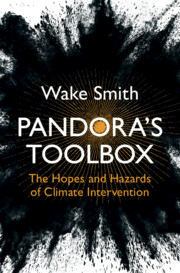Book contents
- Reviews
- Pandora’s Toolbox
- Pandora’s Toolbox
- Copyright page
- Dedication
- Contents
- Figures
- Tables
- Prologue
- Acknowledgments
- Section I Climate Introduction
- Section II Responses to Climate Change
- Section III Carbon Dioxide Removal
- 10 Natural Climate Solutions
- 11 Carbon Capture and Sequestration
- 12 Direct Air Carbon Capture and Sequestration
- Section IV Solar Radiation Management
- Section V Social Ramifications of Climate Intervention
- Section VI The Path Forward
- Acronyms
- Appendix: Detail in respect of Figures 9.4–9.8
- Notes
- Index
12 - Direct Air Carbon Capture and Sequestration
from Section III - Carbon Dioxide Removal
Published online by Cambridge University Press: 24 February 2022
- Reviews
- Pandora’s Toolbox
- Pandora’s Toolbox
- Copyright page
- Dedication
- Contents
- Figures
- Tables
- Prologue
- Acknowledgments
- Section I Climate Introduction
- Section II Responses to Climate Change
- Section III Carbon Dioxide Removal
- 10 Natural Climate Solutions
- 11 Carbon Capture and Sequestration
- 12 Direct Air Carbon Capture and Sequestration
- Section IV Solar Radiation Management
- Section V Social Ramifications of Climate Intervention
- Section VI The Path Forward
- Acronyms
- Appendix: Detail in respect of Figures 9.4–9.8
- Notes
- Index
Summary
The final carbon capture chapter focuses on DACCS and notes that due to difficulties in remediating ongoing emissions from recalcitrant economic sectors such as aviation, long-distance transport, agriculture, and waste streams, DACCS will almost certainly be necessary simply to get to net zero emissions. However, if by then temperatures are unacceptably high, DACCS will be required on an utterly massive scale to reduce atmospheric carbon concentrations. The mechanics of DACCS are quite similar to those required for flue gas capture, but the much reduced concentration of carbon in ambient air elevates the cost of DACCS substantially. While there remains material uncertainty as to the mature cost of DACCS, the size of a future DACCS industry needed to substantially reduce future atmospheric CO2 concentrations would rival the size of the fossil fuel industry today. The three leading companies in the DACCS field are reviewed to illustrate the promising but nascent status of this industry today.
Keywords
- Type
- Chapter
- Information
- Pandora's ToolboxThe Hopes and Hazards of Climate Intervention, pp. 187 - 198Publisher: Cambridge University PressPrint publication year: 2022



